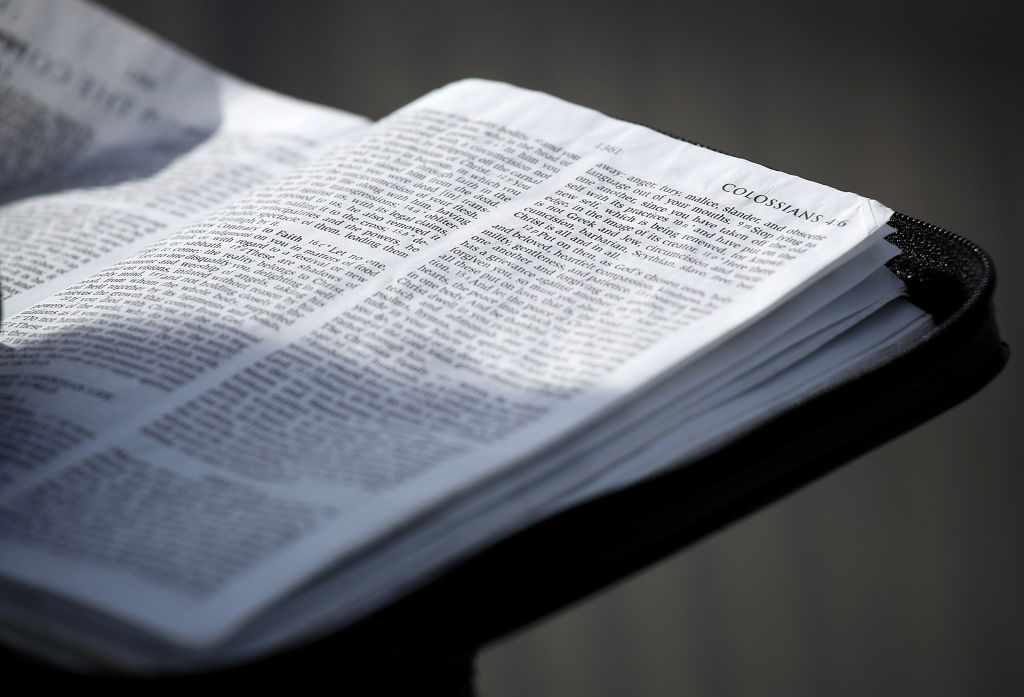Veteran actor David Suchet is no stranger to Biblical readings, but his new Westminster Abbey performance of John’s gospel carries a special poignancy. The combined power of his voice, the abbey’s acoustics, and the breathtaking interior, apt portions of which the camera captured in beautiful synchronicity with the reading, made for a richly resonant experience. And for Christians who are even now being harassed as they seek incarnated fellowship, the reminder that ‘the Word was made flesh and dwelt among us’ is more timely than ever.
Yet the gospel most beloved among laymen is also the most contested among scholars. For some, it is a uniquely illuminating, intimate piece of reportage on Christ’s life and passion. For others, it is a patchwork of evolved fabrications – eloquent, to be sure, but offering small tangible comfort. As one new work treats in depth, even some evangelicals have fallen into the habit of treating John as the red-headed stepchild of gospels scholarship. To the cautious sceptic who asks where the truth of the matter lies, I would reply that while the case in John’s favour may be out of academic fashion, it nonetheless merits a fair hearing.
The full picture John offers, in all its vividness, in its peculiar combination of high drama and mundane precision, confronts the honest reader with the same dilemma that confronted C. S. Lewis
To begin with, there is the matter of John’s eye for precise detail. It is commonly assumed that the author sacrifices on-the-ground accuracy for the sake of theological symbolism. But what symbolic meaning could plausibly be attached to oddly specific numbers like, say, the six waterpots at Cana (each containing ‘twenty to thirty gallons’)? Or the ‘hundred fifty-three’ fish in the great post-Resurrection catch? Or the ‘twenty-five or thirty’ stadia (~3 miles) that the disciples had rowed across Galilee when they saw Jesus walking on the water? See also the frequent ‘approximate hours’ given for various incidents, or awkwardly meticulous descriptions such as the exact positioning of the grave-clothes in Jesus’ tomb.
The number of stadia relates to another puzzle for John’s detractors: the author’s intimate knowledge of his location. Not only does he accurately place the disciples ‘in the middle’ of the lake, as Mark more vaguely puts it, he also knows that this body of water had more than one name (Galilee or Tiberias). This from the same writer who mentions, by the by, that one goes down from Cana to Capernaum (2:12). Further, the gospel’s action, including miraculous action, is grounded in numerous specific sites around Palestine. These include the famous Pool of Bethesda, whose ‘five porticoes’ fuelled many a flight of academic fancy as to their deep symbolic meaning until they were literally excavated in 1964.
In the information age, we can forget the significance of such easy local familiarity. For instance, suppose I, a hobbit-like American writer sitting in my armchair, became suddenly curious about the geography around and under 1980-something Piccadilly Circus, which in the intervening decades has been completely remapped. It’s not as easy as you might think to recover even this recent piece of history, even in 2021. Now imagine instead that I am a Greek writer in the late first or early second century, hoping to fabricate a convincing memoir of the pre-70 A.D. life and times of an itinerant Jewish peasant. Wish me luck in this hypothetical, because I’ll need it.
Numerous details like these certainly appear to mark John as the work of a Jewish writer up close to the facts it relates. Much ink has been spilled over whether that writer is ‘the beloved disciple.’ But there are a number of clues. Note, to give just one, the apparent gap in the crucifixion narrative after Jesus commands said disciple to take charge of mother Mary. This suggests that the writer himself took her away immediately but returned for the bitter end. We then see the eye for detail once again in the vivid clinical shock of blood and water pouring from Jesus’ pierced side, stamped with the seal of eyewitness testimony.
The gospel narrative’s lifelike quality demands to be reckoned with. Characters major and minor leap off the page, from impetuous Peter to doubting Thomas to the barb-tongued man born blind. This is to say nothing of Jesus himself, whose complex personality, teaching style, habits and even small tricks of diction are carried with uncanny unity across all four gospels (significantly weakening the claim that ‘the Johannine Jesus’ and ‘the Synoptic Jesus’ are two different entities).
Then there are the layers of dramatic complexity in sequences like the raising of Lazarus, whose lead-up is fraught with rich emotion as Jesus first contends with the strong-willed Martha, then falls nearly speechless at tearful, heart-broken Mary. See also the unique touches that set the Last Supper on a knife edge of tension – the beloved disciple’s quiet question as to who will betray, or the observation as Judas stands at the open door, on the threshold of betrayal, that ‘it was night.’ And finally, on Easter morning, the crowning moment of the gospel, perhaps of all Western literature, the mother of all eucatastrophes contained in a single word: ‘Mary.’
The full picture John offers, in all its vividness, in its peculiar combination of high drama and mundane precision, confronts the honest reader with the same dilemma that confronted C. S. Lewis: Either its writer unaccountably invented the modern realistic novel fifteen centuries early, or else we are dealing here not with fiction, but with history. In this voice, we hear the ring of truth. In this report, we see the marks of one who bears witness, who can say with confidence, as Ezra Pound would render it, ‘I ha’ seen him eat o’ the honey-comb/Sin’ they nailed him to the tree’.






Comments